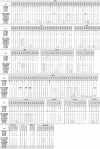Bovine-like coronaviruses isolated from four species of captive wild ruminants are homologous to bovine coronaviruses, based on complete genomic sequences
- PMID: 18842722
- PMCID: PMC2593316
- DOI: 10.1128/JVI.01586-08
Bovine-like coronaviruses isolated from four species of captive wild ruminants are homologous to bovine coronaviruses, based on complete genomic sequences
Abstract
We sequenced and analyzed the full-length genomes of four coronaviruses (CoVs), each from a distinct wild-ruminant species in Ohio: sambar deer (Cervus unicolor), a waterbuck (Kobus ellipsiprymnus), a sable antelope (Hippotragus niger), and a white-tailed deer (Odocoileus virginianus). The fecal samples from the sambar deer, the waterbuck, and the white-tailed deer were collected during winter dysentery outbreaks and sporadic diarrhea cases in 1993 and 1994 (H. Tsunemitsu, Z. R. el-Kanawati, D. R. Smith, H. H. Reed, and L. J. Saif, J. Clin. Microbiol. 33:3264-3269, 1995). A fecal sample from a sable antelope was collected in 2003 from an Ohio wild-animal habitat during the same outbreak when a bovine-like CoV from a giraffe (GiCoV) was isolated (M. Hasoksuz, K. Alekseev, A. Vlasova, X. Zhang, D. Spiro, R. Halpin, S. Wang, E. Ghedin, and L. J. Saif, J. Virol. 81:4981-4990, 2007). For two of the CoVs (sambar deer and waterbuck), complete genomes from both the cell culture-adapted and gnotobiotic-calf-passaged strains were also sequenced and analyzed. Phylogenetically, wild-ruminant CoVs belong to group 2a CoVs, with the closest relatedness to recent bovine CoV (BCoV) strains. High nucleotide identities (99.4 to 99.6%) among the wild-ruminant strains and recent BCoV strains (BCoV-LUN and BCoV-ENT, isolated in 1998) further confirm the close relatedness. Comparative genetic analysis of CoVs of captive wild ruminants with BCoV strains suggests that no specific genomic markers are present that allow discrimination between the bovine strains and bovine-like CoVs from captive wild ruminants; furthermore, no specific genetic markers were identified that defined cell cultured or calf-passaged strains or the host origin of strains. The results of this study confirm prior reports of biologic and antigenic similarities between bovine and wild-ruminant CoVs and suggest that cattle may be reservoirs for CoVs that infect captive wild ruminants or vice versa and that these CoVs may represent host range variants of an ancestral CoV.
Figures



References
-
- Almeida, J. D., D. M. Berry, C. H. Cunningham, D. Hamre, M. S. Hofstad, L. Mallucci, K. McIntosh, and D. A. J. Tyrrell. 1968. Coronaviruses. Nature 220650.
-
- Brandao, P. E., F. Gregori, L. J. Richtzenhain, C. A. Rosales, L. Y. Villarreal, and J. A. Jerez. 2006. Molecular analysis of Brazilian strains of bovine coronavirus (BCoV) reveals a deletion within the hypervariable region of the S1 subunit of the spike glycoprotein also found in human coronavirus OC43. Arch. Virol. 1511735-1748. - PMC - PubMed
Publication types
MeSH terms
Grants and funding
LinkOut - more resources
Full Text Sources
Research Materials
Miscellaneous

